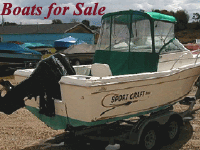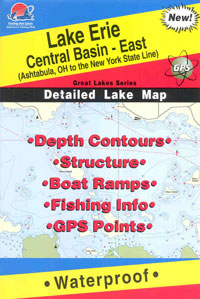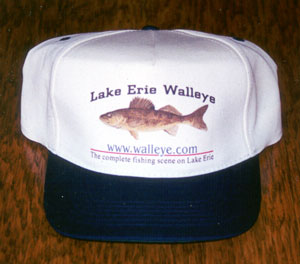So Many Rods, So Little Time
by Rick Olson
So many rods, so many walleyes, so little time. Walleyes are a unique breed of fish and can adapt to a wide variety of situations, which when
translated means you can find them doing a lot of different things in a
lot of different places. It can take an arsenal of weapons (rods) to
handle every situation, and why professional anglers (including me)
carry three or four dozen rod and reel combinations to every tournament.
In fact the total number of rods had been getting out of hand lately,
and I decided to break it all down and see what was really needed and
eliminate the surplus. What I found was that compromise could be reached
and some rods consolidated, some could pull double duty and be used in
more than one application, and a couple that were specific to certain
presentations.
breed of fish and can adapt to a wide variety of situations, which when
translated means you can find them doing a lot of different things in a
lot of different places. It can take an arsenal of weapons (rods) to
handle every situation, and why professional anglers (including me)
carry three or four dozen rod and reel combinations to every tournament.
In fact the total number of rods had been getting out of hand lately,
and I decided to break it all down and see what was really needed and
eliminate the surplus. What I found was that compromise could be reached
and some rods consolidated, some could pull double duty and be used in
more than one application, and a couple that were specific to certain
presentations.
The process started by identifying all of the different presentations
and techniques and then deciding what really was getting used.
Compromise would try to be reached but not at the expense of a
particular presentation, not when I have to fish for my next paycheck.
Jigging has proven over the ages to be an effective method for
catching walleyes and is still just as deadly today. There's a number of
different lengths and actions available and I've probably used them all
but have always come back to a six foot rod with a medium light tip,
like Rapala's Tournament Class model TS70SP60ML1. About the only thing
that varies is the type of line I'm using and depends on the situation.
For pitching jigs to shallow rocks, weeds, or structure I'll always
be using a four to six pound test high vis monofilament line because it
makes line watching so much easier. Vertical jigging in deeper water can
also be accomplished but a no stretch super braid in the same high vis
color may be in order. Same rod, two completely different applications.
Rigging is another mainstay and a seven foot medium light rod is
perfect for detecting subtle bites and battling big walleyes on light
line like Rapala's Tournament Class model TS70SP70ML1 It's also happens
to be an excellent rod for casting lighter crankbaits and for using slip
bobbers. The difference again is the line; with mono covering most of
the rigging (except the really deep stuff) and a braid for casting
cranks and using slip bobbers. Most anglers wouldn't think of using a
super braid with slip bobbers but it really does work and is perfect for
working around trees and over sunken brush piles because of it's
excellent abrasion resistance properties.
The longest rod in the box is a nine and a half footer with a medium
light action tip like Rapala's Tournament Class model TS71TR96M2, that
can be used for dead sticking or for cranking with a no-stretch line.
The extra length is perfect for rigging up a lighter bouncer with a live
bait rig and then putting it in a rod holder and waiting for the soft
tip to reveal the light bite of a fish. The long rod is limber enough to
keep a walleye from detecting your presence and give you time to pick up
the rod and set the hook. It also has the right action for working with
braided lines and crankbaits because you can see how a bait is running
by the vibration in the tip, and because the long soft action will help
you fight and land fish without ripping the hooks lose.
My bottom bouncers rods get plenty of use including live bait rigging
and dragging a spinner and crawler harness around. In the past; a six
footer covered the spinners and a seven footer was used for rigging. The
compromise is a six and a half footer with a medium action tip like
Rapala's Sportsman's Classic model SNC30TR66MH1 that covers both
applications without really giving up anything.
Trolling rods can vary but an eight and a half footer casting rod
with a medium action tip like Rapala's Tournament Class model TS70TR66M1
will cover most of it, and can be used with mono or leadcore. Mono is
preferred for running cranks in shallow water and leadcore when you're
dealing with deep water or current. The little stiffer action will
handle the extra weight of the leadcore line and will let you see how
your baits are running in the tip. By using a no-stretch leader in front
of the leadcore I can actually see how a #5 Shad Rap is running in over
forty feet of water, and running clean and straight is extremely
important.
Armed with a half dozen rods and reels along with some extra spools
filled with couple of different line weights and types you can cover
just about any situation you're faced with. That is unless you can
legally fish with more than one line, or you're expected to provide the
equipment for a companion, or you're expected to provide the equipment
for a companion and you can fish with more than one line. Are we back to
where we started?






 breed of fish and can adapt to a wide variety of situations, which when
translated means you can find them doing a lot of different things in a
lot of different places. It can take an arsenal of weapons (rods) to
handle every situation, and why professional anglers (including me)
carry three or four dozen rod and reel combinations to every tournament.
In fact the total number of rods had been getting out of hand lately,
and I decided to break it all down and see what was really needed and
eliminate the surplus. What I found was that compromise could be reached
and some rods consolidated, some could pull double duty and be used in
more than one application, and a couple that were specific to certain
presentations.
breed of fish and can adapt to a wide variety of situations, which when
translated means you can find them doing a lot of different things in a
lot of different places. It can take an arsenal of weapons (rods) to
handle every situation, and why professional anglers (including me)
carry three or four dozen rod and reel combinations to every tournament.
In fact the total number of rods had been getting out of hand lately,
and I decided to break it all down and see what was really needed and
eliminate the surplus. What I found was that compromise could be reached
and some rods consolidated, some could pull double duty and be used in
more than one application, and a couple that were specific to certain
presentations.